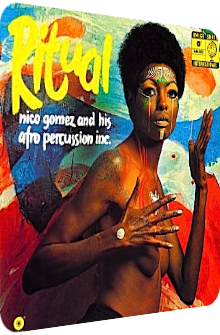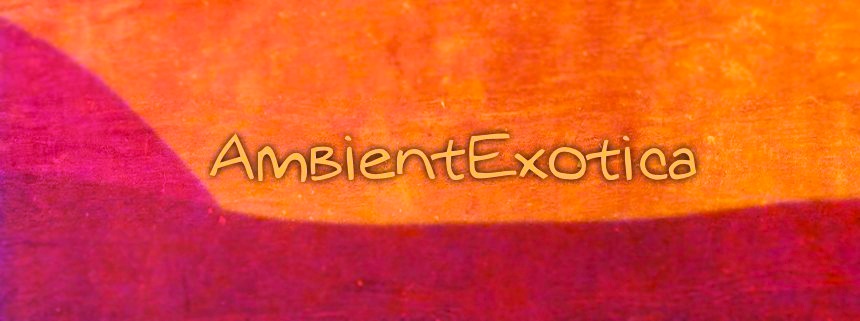
Nico Gomez
Ritual
1971
Ritual by the Belgian conductor and composer Nico Gomez and His Afro Percussion Inc. is a multifaceted work which intertwines equal parts of Funk, Afro-Bop, Latin traditions and Exotica in order to knock up a tasty spectacle. Originally released in 1971 on Omega International and re-issued in 2013 on CD and as a digital version by the Mr Bongo label, its ten tracks sound as dynamic and fresh as they did back in the 70’s. As happens with the overwhelming majority of works created in the decade of Funk, one question sooner or later arises: is this is a real Exotica work? The genre largely ceased to exist around or shortly after 1965, with every subsequent work moving farther away from both the vintage Jazz sound of quartets and the dreamy Exotica symphonies. And naturally, Nico Gomez’s work draws from many influences and features electric guitars aplenty, the divisive marker between the Golden Fifties and the Funky Seventies.
If the listener is fine with those pseudo-savage wah-wah guitars or even embraces them, chances are that Ritual is the album of one's dreams. The conductor worships the past and offers classical gold standards as well as unique material specifically written with the album in mind. Ritual is so great due to its abundance of textures. It really feels like “the good old days,” and in the meantime became a vintage record itself! Colorful brass rivers, gorgeous percussion layers – caixhas, guiros, djembes, cowbells, congas and bongos are among the instruments – and guitars of all kinds are used, the album is opaquely divided into faster songs and slowly slacking stumblers. Spanish lyrics and exhilarative shouts round off the splendidly melodious peripheries. A high budget production devoid of over-produced perfectionism, Ritual is adamantly cool and veritably mellow, simply enchanting. Read more about a less considered, somewhat hidden Exotica album below that has clearly deserved its reissue and place near the sun.
Five seconds into the opener Caballo Negro, originally envisioned by Pérez Prado, and one knows the stylistic tone of Nico Gomez’s album. This is the 70’s alright: spiky four-note guitar prongs, madly shouting savages, cowbell-interspersed bongo thickets and gorgeously quavering Hammond organ coils meet brass sections that are so much over the top that they are perpetually gleaming. Be it the hefty organ staccato, the euphony of the tachycardia trumpets or the increasingly jocular all-male chants, this is mighty fine Afro-Exotica, delightfully eclectic rather than perfectly streamlined. The electric guitars and their wah-wah backing brethren fuel the sleazy groove from down below, aptly transforming Prado’s late 50’s material into the wild 70’s. The following Naci Para Bailar is written by the Belgian orchestra leader himself, but perfectly blends with the tropical frenzy. A tad less hectic, it comprises the same organ goodness but revs up the presence of the wah-wah guitars. The singers reside in poppier realms akin to James Last’s bonfire hippiedom. And indeed, Gomez’s tune is placed in this very tradition, but makes sure that its benign sunbursts are fueled by the percussion underbrush at all times, never letting the aura of the tropics decrease.
Cuba Libre is another original cut, but could have been distilled of Xavier Cugat’s Cugi’s Cocktails (1963). A monotonous shrapnel of horns and organ crystals shatters into a partly cool, partly lamenting Latino corker with the typical brass backings and figuratively celestial organ panoramas which ameliorate the alloy of the chorus. Encapsulated in warmth and exciting euphony, it is the exciting counterpart to the labyrinthine electric guitar shrubbery. The polyphony of the choir is really great, this tune absolutely rocks. The organ even outshines the otherwise skillfully injected percussion placenta.
Antonio Carlos Jobim’s Samba De Una Nota So follows, better known in Anglo-American lands as One Note Samba. Potentially the easiest Samba to play – its title gives the reason away –, it is first and foremost the electrifying beauty of the laid-back guiro- and maraca-laden conga groove and the hyper-mellow acoustic guitars which enchant and add another stylistic layer to the album. On top of this, dreamy alto flutes are grafted, an additional iridescent organ reminds of Walter Wanderley’s pool of textures, and let me not forget the easygoing midtempo structure which does not link back to the album title at all, but offers a true fleeting visit to vintage Exotica with organ-ic traces of Space-Age. One of my absolute favorites, so enormously lofty, carefree and almost (but not really) on par with Barney Kessel's stupefying rendition that is found on Contemporary Latin Rhythms (1963). The Funk returns in Nico Gomez’s own Baila Chibiquiban. Incisive whiplash-like “baila” shouts, heavily spiraling electric guitars and darker blebs nurture the cool metropolitan slickness. This is probably the most archetypical Funk excursion, even the percussion does not sound eminently tropical. The Portuguese chants make sure to remind the listener of the overarching theme, though.
Side B opens with a sunsetscape: Nico Gomez’s El Condor Pasa is hued in warm colors and clinging cowbells, features a beat that schleps itself forward and literally glows due to the thermal heat that reigns in this song. The base framed comprises of a classical Pop structure with male desperados singing melancholic, boldly grandiloquent and poeticizing lyrics about the titular bird. Acoustic guitars and sanguine organ washes round off the boldest of all Latin tunes of this album. Pérez Prado’s Lupita then reintroduces the listener to the wonderfully convoluted percussion prowess, luminescent organ globs, euphoric horns and designedly wonky-elasticized guitar twangs. The topic of this quasi-Mambo is naturally all about female beauty. The chants are thus standardized and the electric guitar cascades the boldest marker of the 70’s. On the plus side is the generous duration of percussion-only segues. These showcase the textural variety yet another time.
While Nico Gomez’s own Pa! Pa! Pa! Pa! is slow as molasses but fills its mega-sleazy rhythm with screeching organ vesicles, pa pa pa lyrics and horn-based lightning bolts before venturing into faster beats in the particularly catchy chorus section, it is the frilly title track Ritual which surprises with vertiginous pre-Drum ‘n Bass patterns, smoking hot organ accents and smashing horns that live up to the Latin sub-theme in all its glory. Co-written by Nico Gomez with his son who appears under his alias Raymond Lolandson, Ritual is not savage or tribal at all but rooted in the tropical climate of a concrete jungle. The mixture is awesome: prolonged and dense drum patterns, luminescent organs and brass sections that are anything but hooking make this a towering tune.
he outro Eso Es El Amor by the mysterious composer I. J. Angel is a slow guiro-backed critter with maracas, chants by a mixed choir and several rhythm shifts. The fissured structure of the arrangement as well as its stop-and-go motion allows the instruments’ afterglow to illumine the black backdrop. Nico Gomez’s album ends on a melancholic note, a minor disappointment given the huge doses of glee that came before the finale.
Ritual offers a wonderful blending of Afro-Bop, Latin, Funk and Exotica. There are of course many listeners who despise electric guitars, as these modern devices seem to kill the vintage flavor and boost the unwanted modernism, thereby potentially killing the timeless aura of a work. I won’t argue with these impressions, but can assure those listeners that Nico Gomez’s work is not as harsh or overly bustling as its title suggests. While closely tied to the Afro-centric style of Geoff Love’s famous British Exotica orchestra called Mandingo, Ritual lacks the cinematic and brutish scope without ever sounding bland or lackluster. The Belgian composer is clearly keen on Pop structures and jazzier interludes, but this does not mean there is no mercurial interdependence between its ingredients. In fact, the album is so well-balanced that there is not one single texture or instrument to outshine them all! The brass eruptions are top-notch, totally spacey, crazy and benign, the Hammond organ blows off any cobwebs and shimmers in translucent colors regardless of whether it is played in legato or staccato, and the percussionists ennoble the compositions ever-further.
Despite the large amounts of Latin shouts and Spanish lyrics, Nico Gomez does not fall into the cliché trap… once he does, he finds his way out immediately. There is no lamenting or yearning, only a slight melancholia in a song or two. The rest is a surprising amount of midtempo and slow critters, surprising by means of the album title. My absolute favorite, perhaps consequentially so, is the dreamscape that is Antonio Carlos Jobim’s One Note Samba. Gomez’s interpretation puts the acoustic guitars into the limelight, but these are neither sappy nor Balearic but delicately silkened. It is also the only song with alto flutes and hence evokes that certain vintage feeling which is so desired in Exotica circles. Cuba Libre and the title track Ritual are equally strong, unique offerings and extremely catchy. Nico Gomez’s album is the mediator between vintage lands and the harsher safaris of Mandingo. If the one is too bland and the other too vigorous-frantic, Ritual might be the fitting piece. It is available on vinyl, in a CD reissue of 2013 and a download version.
Exotica Review 260: Nico Gomez – Ritual (1971). Originally published on Sep. 14, 2013 at AmbientExotica.com.
